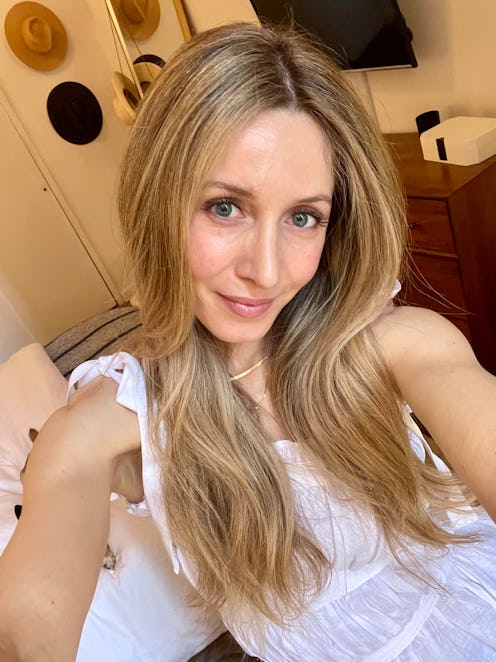(Hair)
A Base Break Is The Secret Sauce To Finding My Perfect Blonde Shade
The low-maintenance color service is perfect for summer.

“Never satisfied” might be the most accurate, albeit shameful, way to describe my hair color temperament. Actually, that’s too harsh. My biggest problem: I constantly change my mind. Right now, I’m in an au naturel phase like many have entered into during the pandemic. But now, a rather dim and mousey shade that toes the dirty blonde and (gulp) light brown line is growing in, and I have no interest in embracing it. Luckily, I’ve come upon a triumphant discovery: base breaks, a low-maintenance color service that’s presently the secret sauce to achieving my perfect blonde shade.
At one point, bone-chilling platinum was the entirety of my hair goals. But after my strands tragically snapped off and a painfully slow regrowth process endured, I got over wanting that particular shade. I’ve since toyed with full-on grow-outs of my natural color to avoid bleach damage altogether, which never last. I invariably find myself back in the salon chair, asking to be made “as bright as possible, without wreaking havoc.” Reasonable, yes? My colorist, Lucille Javier of Mark Ryan Salon in New York City, is always up for the challenge. She’s gotten me to a much-brighter-than-my-natural but very-natural-looking shade by combining strategically placed highlights with the base break coloring technique (also known as a base bump or smudging).
“I wanted to really up the lightness around your face so you would feel brighter,” Javier tells me just after my recent pre-wedding color appointment. “This also [causes] less damage and achieves a lightness that reads well for photos,” she continues — two factors she knew were important to me ahead of the momentous occasion. “Essentially, trying to do more with less damage and achieve the lightest result,” she adds. For a deeper explanation of the service, Javier breaks it down further.
“A base break essentially lightens your natural base color to create an effortlessly brighter tone all around to mimic a blonder highlight,” she says. Another way to think of it, as Tina Hake — a Honey Comb Hair Design master colorist and BaByliss Pro Education Manager — tells me: “[A base break will] diffuse the root line.” Javier adds, “Typically, the lightest shade is achieved at the hairline, leaving you with a softer and more natural look.” Ahh, natural — my exact aim.
In addition to a softer hairline, Reece Walker, a bicoastal colorist, stylist, and hair extension expert (you can book a spot with him in NYC or LA), says base breaks afford a smoother regrowth process. They also allow for more space between highlight appointments if you’re embracing the “rooty” color trend or want to lessen the risk of damage. “They’re great if you’re trying to soften your client’s hair and stay away from too much bleach,” he says.
The base break process is simple. “They’re done very quickly at the sink,” Javier says, as opposed to an all-over base color which tends to take longer to deposit and is mainly used to cover grays. “The difference is a base break lifts the hair lighter quickly,” she says. Hake describes base breaks as a “flash service” that “can lift the natural hair by up to three full levels and can take up to an hour to do.” Mine took about five minutes — a standard process time for anyone lightening by one shade.
Javier says base breaks work for all hair types, including brunettes and redheads, telling me, “you can formulate it for anybody.” But she and Walker warn the service results in a warmer color. “I don’t do a lot of base breaks as many of my clients are liking a cooler result in their blonde,” Walker says. “However, I have a few clients that I base break with a very light ashy/mousey natural color that love a warmer golden hue to it.” His final word: “I would not recommend a base break if you don’t like warmth.” Javier suggests speaking with your colorist to ensure the service will achieve your desired results.
Hake agrees that a base break can work on all hair colors and is “a good gateway into going grey gracefully.” However, she says the service suits clients with lighter hair best as it only softens the root area color. “It’s used mainly in blonding services,” the colorist explains. “If the natural hair color is really dark, it won’t lift quite enough,” adding that, “[Base breaks] can be used to soften or blend the root area for lighter brunettes and redheads, like strawberry and honey blondes.”
Essentially, a base break is the perfect low-maintenance color service to try between highlight appointments or as an add-on for a softer root area, just as I hoped for ahead of my wedding and during summer (pending I don’t change my mind again). Ultimately, the effect is subtle, but if you’re embracing the natural color tone trend or want to ease into grey, Hake says it’s “a great option in-between color services.”
For those in the natural blonde to dirty blonde range, Javier also tells me how a base break can soften up the look of hair and lighten it in a way that would naturally happen in the sun, hitting the top of the head and around the hairline. “It will lighten the most around the face frame, which always looks very appealing,” she explains. Her final word: “I like to think of this as another tool in my paintbox. It’s an amazing tool for the right client.”